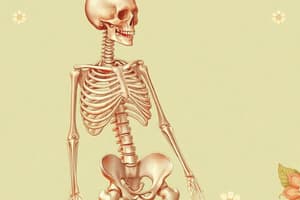Podcast
Questions and Answers
What percentage of an adult's total body weight is typically accounted for by the skeleton?
What percentage of an adult's total body weight is typically accounted for by the skeleton?
- 10%
- 22%
- 18%
- 14% (correct)
At what age does bone mass typically reach its maximum?
At what age does bone mass typically reach its maximum?
- 20 to 25 years
- 35 to 40 years
- 25 to 30 years (correct)
- 30 to 35 years
Which type of bone is primarily responsible for protecting internal organs?
Which type of bone is primarily responsible for protecting internal organs?
- Long bones
- Short bones
- Irregular bones
- Flat bones (correct)
How many bones does the average human skeleton have at birth?
How many bones does the average human skeleton have at birth?
What type of bone makes up about 80% of adult bone mass?
What type of bone makes up about 80% of adult bone mass?
What are the two main groups of the human skeleton?
What are the two main groups of the human skeleton?
Which of the following bones is part of the axial skeleton?
Which of the following bones is part of the axial skeleton?
What is NOT a function of the skeletal system?
What is NOT a function of the skeletal system?
Which type of muscle is responsible for involuntary movements in the heart?
Which type of muscle is responsible for involuntary movements in the heart?
How many muscles does the human body contain, approximately?
How many muscles does the human body contain, approximately?
Flashcards are hidden until you start studying
Study Notes
Skeletal System
- The human skeleton accounts for around 14% of a person's total body weight.
- The average adult male skeleton weighs around 27.5 pounds, while an adult female's skeleton is roughly 23 pounds.
- Bone mass reaches its peak between the ages of 25 and 30, but this can vary depending on factors like nutrition, activity level, and overall health.
- The human skeleton comprises around 270 bones at birth, which decreases to about 206 bones in adulthood due to the fusion of some bones.
Structure of the Skeletal System
- Bone tissue is made up of two types: compact and cancellous.
- Compact Bone is a hard outer layer that is dense, strong, and durable. It makes up about 80% of adult bone mass and forms the outer layer of bone.
- Cancellous Bone makes up the remaining 20% of bone and consists of a network of trabeculae, or rod-like, structures. It is lighter, less dense, and more flexible than compact bone.
Types of Bone
- Flat Bones protect internal organs such as the brain, heart, and pelvic organs. They're flattened, providing a shield for internal organs. Examples include skull bones, ribs, and the sternum.
- Long Bones support the weight of the body and facilitate movement. They are mainly located in the appendicular skeleton and are longer than they are wide. Examples include the femur, tibia, fibula, humerus, radius, and ulna.
- Short Bones provide stability and limited movement. They are roughly cube-shaped and found in the wrists and ankles. Examples include the carpals in the wrist and the tarsals in the ankles.
- Sesamoid Bones are small, round bones embedded in tendons. They are commonly found in the tendons of the hands, knees, and feet. The patella (kneecap) is a good example.
- Irregular Bones vary in shape and structure and don't fit into the other categories. They often have complex shapes and help protect internal organs. Examples include the vertebrae and the facial bones.
Skeletal Groups
- The bones of the skeleton are divided into two groups: axial and appendicular.
- Axial Skeleton: Consists of the bones of the skull, vertebral column, and thoracic cage. It provides support and protection for vital organs.
- Appendicular Skeleton: Consists of the bones of the limbs, shoulders, and pelvic girdle. It allows for movement and locomotion.
Function of the Skeletal System
- Movement: The skeletal system provides a framework for muscles to attach to, allowing for movement.
- Support: The skeleton supports the weight of the body and gives it shape.
- Protection: The bones protect vital organs from damage. For example, the ribcage protects the heart and lungs, and the skull protects the brain.
- Blood Cell Production: Bone marrow, found within certain bones, produces red and white blood cells, which are essential for oxygen transport and immunity, respectively.
- Mineral Storage: Bones serve as a reservoir for important minerals like calcium and phosphorus, which are required for various bodily functions.
Muscular System
- There are three main types of muscle: skeletal, cardiac, and smooth.
- Skeletal Muscle is responsible for voluntary movement. It makes up about 40% of a person's body weight.
- Cardiac Muscle is involuntary muscle tissue found only in the heart. It contracts to pump blood throughout the body.
- Smooth Muscle is found in the walls of internal organs, respiratory passageways, and blood vessels. Its contractions are involuntary and help regulate various bodily functions.
Studying That Suits You
Use AI to generate personalized quizzes and flashcards to suit your learning preferences.




